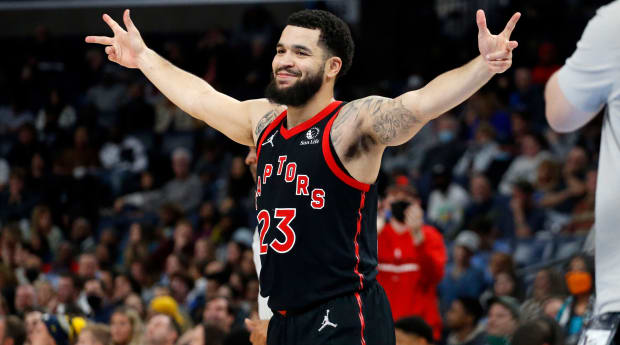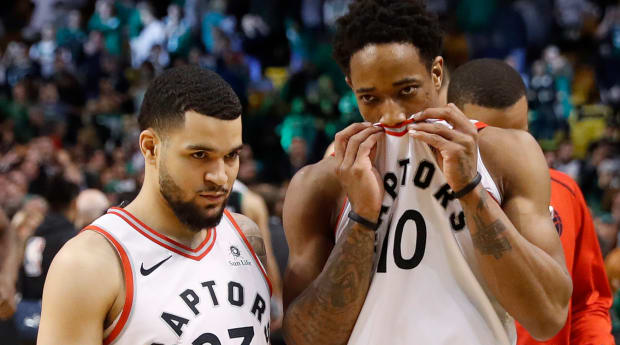Fred VanVleet is an emerging NBA star, but not a star in any of the ways that anyone would readily recognize. To wit: Fred VanVleet does not soar over helpless defenders, nor mesmerize them with a killer crossover, nor dazzle us with physics-defying passes. Fred VanVleet is not a 7-foot “unicorn.” He is not a “cheat code.” He is not “breaking the game.” The game will probably survive Fred VanVleet.
The beauty of VanVleet’s stardom is that there is nothing sparkly about it, just a bright, steady pulse of winning plays—pinpoint passes, clutch threes, timely rotations, snarly defense—the stuff that doesn’t go viral on Twitter, but makes coaches happy and the Raptors hum.
He’s averaging a stout 21.7 points per game, though that ranks a modest 22nd among the league’s top scorers. He’s nailing 39.2 percent of his threes, an excellent mark that nevertheless ranks 37th. His 7.0 assists per game are handy, but place him just outside the top 10.
And yet, you underestimate VanVleet at your own peril. Ask the Jazz, who watched him pile up 37 points, 10 rebounds and 10 assists in a Raptors victory on Jan. 7. Or the Knicks, who he drilled for 35 points (including seven three-pointers) five days earlier, also in a win. Ask the Sixers, who were felled by a VanVleet dagger three with 24 seconds left in a Nov. 11 Raptors win.
Or ask the East-leading Heat, who lost to the Raptors in triple-overtime Saturday night, with VanVleet delivering key three-pointers in the second and third extra periods, each from 29 feet, the last one providing the final margin of victory.
Undrafted in 2016, underestimated perennially, VanVleet is quietly weaving his own brand of stardom—and might soon be certified as an actual NBA All-Star. Reserves for the Feb. 20 game in Cleveland are now being selected by a vote of head coaches. VanVleet is firmly in a mix that includes James Harden, Zach LaVine and LaMelo Ball— all marquee names and lottery picks.

Petre Thomas/USA TODAY Sports
Oh, and then there’s this: VanVleet’s current averages (at least 21 points, six assists and four rebounds) place him in a club with just 10 others, including the current MVP (Nikola Jokic), three former MVPs (Harden, Stephen Curry, LeBron James), a likely future MVP (Luka Doncic), the league’s newest darling (Ja Morant) and four established stars (Jimmy Butler, Trae Young, Damian Lillard, Bradley Beal).
VanVleet’s place in this conversation somehow feels both stunning and unsurprising, which explains the grin that spreads across his face as he settles into an oversized hotel lobby chair to discuss it all. He knows he belongs here. He knows he’s earned it. He knows he doesn’t fit the part, and he’s proud of that too—his swagger offset by his humility.
“It’s a good list,” VanVleet says, still smiling. “Sounds about right to me. Sounds about right where I feel like I belong at. … I just try to work hard, be humble, go out there, lay it on the line every night for the team and, you know, whatever comes my way after that, I’ll take it. But I definitely think very highly of myself, in my own head. I don’t speak on it too much. But, um, that sounds about right.”
This season, Toronto’s first without Kyle Lowry running the offense, VanVleet has firmly established his value, leading the young Raptors back into playoff contention after a dismal 27–45 campaign last season. They’re 1–4 in the games he’s missed this season, and 5–19 without him over the last two seasons.
In the abstract, VanVleet’s rise is indeed stunning. Players with his modest physical profile rarely become stars in this league. And undrafted players? Almost never. Of the 438 players to be named “All-Star,” only five were undrafted: Connie Hawkins and Moses Malone (who began their careers in rival leagues), Brad Miller, John Starks and Ben Wallace. It’s been 16 years since Wallace’s last All-Star appearance.
And yet the hints of VanVleet’s emergence—his diligence, his focus, his steady, methodical evolution—have been there all along. He has improved in every major statistical category, every season, for six years. He’s long fit the “first to the gym, last to leave” profile that endears him to coaches and teammates. No, no one saw this coming. But they did see something, from the very start.
“He’s never satisfied with nothing,” says DeMar DeRozan, a teammate for VanVleet’s first two seasons. “He carries himself like he's got the biggest chip on his shoulder. He carries himself like he’s 6' 8". And however tall Freddy is—5' 8", whatever he is,” DeRozan says, chuckling. (VanVleet is listed at 6-1). “That’s the type of heart he has, so it’s not surprising me at all. Besides being a friend of his, I’m one of his biggest fans. Love watching him compete, and in my opinion, I think he should be an All-Star.”

Winslow Townson/USA TODAY Sports
DeRozan recalls watching VanVleet tear up the competition for Toronto’s G League team, then turn around and play for the Raptors—“and compete like he belonged.” He recalls watching him go head to head (and sometimes, jaw to jaw) with star point guard Kyle Lowry in scrimmages.
“He never backed down,” says Norm Powell, who played four and a half seasons with VanVleet. “There would be some arguments and going back and forth with Kyle, and it was just fun to see the competitive drive in him. … I think that’s what made him and Kyle’s relationship so special, that he saw that pit bull and that undersize dog mentality that Kyle brought to the table. (VanVleet) always used to tell me, he can do what Kyle does.”
Coach Nick Nurse, an assistant under Dwane Casey when VanVleet first arrived, recalls seeing a young player who “isn't that athletic, but has great feet, that can really move side to side” and had a “unique ability to finish at the rim,” despite his stature. He also recalls a “fearlessness.”
“I was always amazed at him rolling down the lane with a 6' 10" guy on him and somehow getting it in the basket,” Nurse says with a laugh. “Like, how does he do that? He doesn't even really jump, and he somehow gets his body between the man and gets it over them and spins it in there somehow.”
Which is all great, of course, but as Powell notes, “I was never sitting back like, ‘Oh, yeah, man, Fred’s gonna be an All-Star. … It was just an everyday development and a mental focus and want-to.”
The difficulty in being undrafted isn’t, of course, about a lack of talent; VanVleet is proof of that (“I mean, I was one of the best college players in my four years,” he says). No, he says, it’s the damning low expectations that come with the label. Lottery picks get lavished with attention and early opportunities. Lower first-rounders get their share of minutes, too, because the team wants to see a return on investment, to prove they picked the right guy. But no one’s career rides on the undrafted guy.
“Now I’m the guy that's over on the side, who’s shooting by myself,” VanVleet says. “I didn’t have the front office telling the coaches to play me. I wasn’t even signed to a big agency. I didn’t have agencies reaching out to reporters on my behalf. And that’s the stuff that plays a part in the business of the game, and I didn’t have an equal opportunity, until I got my feet in the door. And then I did the rest by myself.”
“Nothing was given to me,” he says. “That’s what I take pride in.”
So much of a player’s rise comes subtly, in minor adjustments and additions to their repertoire. For VanVleet, it was first shifting his game from the midrange to the three-point line, at Lowry’s urging. And after honing that shot going to his left, it was working to make them going right. Then it was shooting deeper threes.

Kyle Terada/USA TODAY Sports
VanVleet claimed a share of stardom in the 2019 Finals, when he broke out for 22 points in the title-clinching Game 6 victory over the Warriors. But that series mostly belonged to Kawhi Leonard, Pascal Siakam and Lowry.
In VanVleet’s own telling, the key moment came early the following season, when Lowry was injured for nearly a month, and VanVleet stepped in as the Raptors’ primary playmaker, averaging 21.2 points and 7.5 assists, while shooting 40 percent from three-point range and leading Toronto to a 9–2 record.
“And I started to look, like, ‘OK, I could do this,’” VanVleet says. “That was the first time where I saw that it was possible.”
Of course, everything since then has been, as VanVleet says, “a whirlwind, a rollercoaster of emotions.” The pandemic. The shutdown in March 2020, and the “bubble” season that summer. The Raptors’ forced relocation to Tampa for the entire 2020-21 season. The departures of all the Raptors’ key veterans, from Leonard to Marc Gasol and Serge Ibaka and finally, last summer, Lowry. The one constant has been VanVleet.
“We’ve kind of seen it all, done it all,” he says. “The entire world went through something. People lost their lives. We were obviously displaced into a different city, which was weird. A hell of an experience, but like, I just try to focus on what's in front of me and like the work.”
Now the Raptors are back in Toronto, but their arena has been emptied of fans, by government edict. They’re the only NBA team playing home games in an empty building.
“In my opinion, Tampa was better than what we’re doing right now,” VanVleet says. “We have an incredible homecourt advantage, we’ve got an incredible fan base, and not being able to play in front of those fans,” he trails off. “At least in Tampa, I could go for a walk and have shorts and a t-shirt on, have a coffee and drive with the top down.”
Watching Lowry, a close friend and mentor, leave for Miami last summer was another difficult adjustment. But it’s fair to say that Lowry’s absence now is as critical to VanVleet’s evolution as his presence was the prior five years.
“I don’t think I could probably ever reach my full potential with him there,” VanVleet says. “He’s such a big force and such a big personality, especially in Toronto. … The problem was, he left a big, Kyle Lowry-size hole on the team that is like impossible to fill. So as much as I'm stepping into my new role and what I do, I’m not really replacing what he did.”
Perhaps not, though he’s doing a pretty fair simulation of the player he’s been endlessly compared to, both in build and toughness. Another relevant reference point: Lowry, though drafted in the first round (24th) in 2006, also built a career that’s far exceeded expectations. It took Lowry nine seasons to become an All-Star, at age 28. VanVleet could do it at 27.
Still, recognition isn’t coming easily. VanVleet finished seventh among all Eastern Conference guards in the fan balloting for the All-Star Game. When the Inside the NBA hosts picked their reserves on Thursday night, only Charles Barkley named VanVleet.
“I’m not as popular as any of those other guys that are above me,” VanVleet says. “And I understand that. I’m very honest with myself about that. But I do feel like I’ve been playing good basketball. And luckily, it’s more than just the fans that gets you in there.”
The benefit of being Fred VanVleet is no one sees you coming. The downside is they might be slow to recognize your greatness. You could say he’s the pot in the old lobster-pot analogy: By the time the water comes to a boil, it’s too late. VanVleet’s already cooked you.







